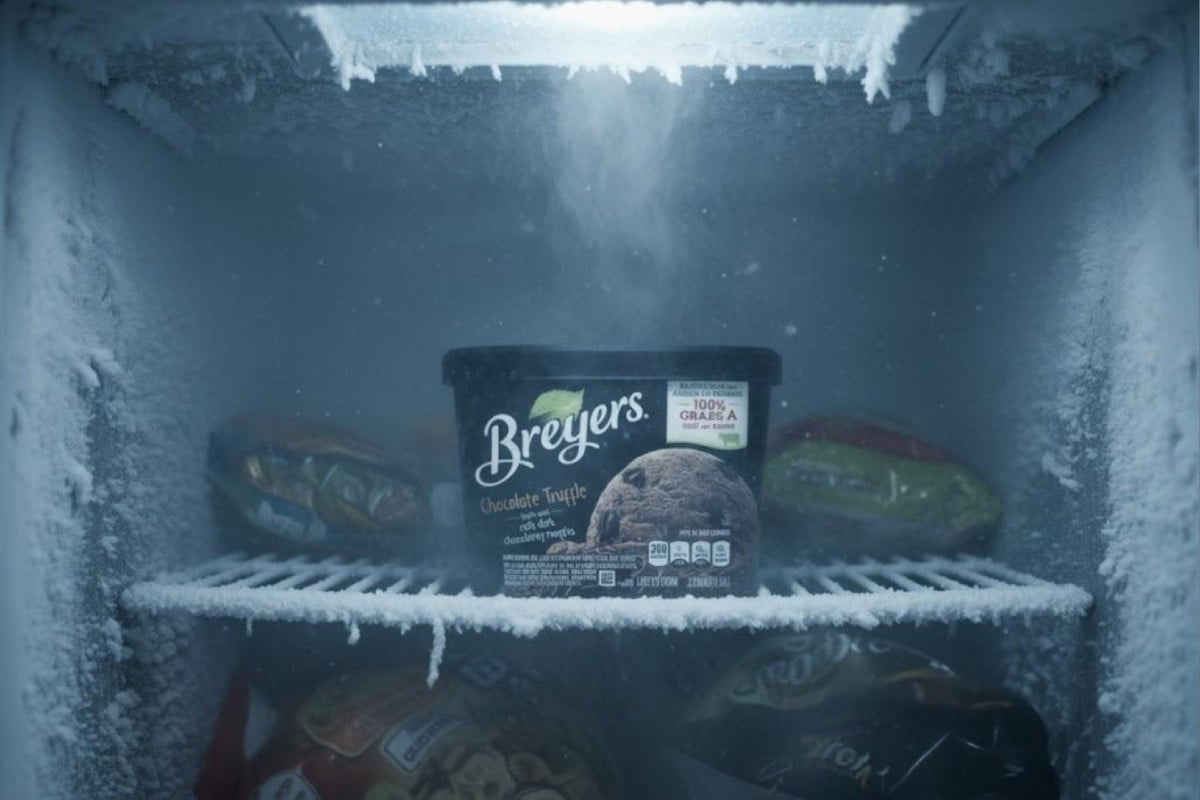
There’s nothing worse than dreaming about ice cream and finding your pint of Ben & Jerry’s has frozen solid as a I rock.
I’ve been there more times than I care to admit. There’s nothing more upsetting than bending a spoon, trying to get some ice cream.
After the last bent spoon, I decided to figure this out once and for all. I wanted to know if there was a way to keep ice cream soft in the freezer, turns out there are a bunch of ways and here they are.
1. The Ziploc Bag Trick (It Really Works)
I first saw this one on Twitter from food writer @Rob_Mahar07, who swore that sealing ice cream inside a freezer-safe Ziploc bag keeps it scoopable.
“Storing ice cream in a ziplock freezer bag can indeed help maintain its creamy texture by preventing ice crystals from forming.”
He was right.
I slipped a half-eaten tub of chocolate-fudge brownie into a gallon-sized bag, squeezed out the air, zipped it tight, and froze it flat. The next night? Perfectly scoopable.
Why it works:
Air is the enemy. It’s what creates ice crystals and freezer burn. Sealing the container in a bag keeps air out and moisture locked in, so the surface doesn’t freeze.
For those who want a visual guide, you can check out this quick little video below.
2. Store It in the Back of the Freezer
This tip came straight from @grandolcreamery, and it’s so obvious once you hear it:
“Keep your ice cream in the back of your freezer where the temperature stays most stable.”
Every time you open the door of the freezer, warm air hits the front section.
That causes tiny thaw-refreeze cycles that destroy texture and create that crunchy layer of frost.
Move your ice cream to the very back, tucked behind the frozen peas, and it stays cold, consistent, and soft enough to scoop.
3. Press Plastic Wrap on Top Before Closing
If you’re halfway through a tub, here’s another simple move that changed everything for me:
Before putting the lid back on, lay a piece of plastic wrap flat against the surface of the ice cream.
That’s it.
Why it works:
It blocks out air completely, forming a little protective “skin” that prevents those crunchy crystals from forming. Perfect for when you’re slowly working through a pint (no judgment here).
4. Double-Seal the Lid (Even New Pints)
Some ice-cream tubs, especially the cardboard kind, don’t seal tightly. That tiny gap between the lid and the container lets cold air creep in and moisture escape.
Now, before I even open a new pint, I wrap the lid with a little plastic wrap or foil. For half-eaten ones, I double-bag the whole container inside another Ziploc.
It’s the “winter coat” method, no freezer burn, no frost buildup, and the ice cream stays soft for weeks instead of days.
5. Use the Middle Shelf, Not the Door (or the Back Wall)
Most people assume colder is better, but if your ice cream is rock-hard, it’s probably sitting in the coldest spot, right against the vent or back wall.
That’s where the freezer blows its coldest air.
Move it to the middle shelf, a few inches from the back. That zone stays steady around –5 °F (–20 °C), cold enough to preserve the ice cream but not so cold it becomes a brick.
If your freezer has a “soft-freeze” or “dessert” setting, use it. It’s not marketing fluff; it’s designed exactly for this.
6. Label, Rotate, and Respect the Expiration Date

This one’s not sexy but it’s real: the longer ice cream sits in the freezer, the more moisture it loses and the harder it gets.
So I treat my pints like FIFO inventory, first in, first out.
Every couple of weeks, I rotate the older ones forward and stash new ones in the back.
And yes, I write the date on the lid with a marker. It’s not about being organized, it’s about saving texture.
Ice cream ages, even when frozen. Keep it moving and you’ll always have a pint that tastes close to the day you bought it.
7. Check Your Freezer Temperature
If none of this seems to help, your freezer might simply be too cold. Most home units are set to 0 °F (–18 °C) or lower by default, but for ice cream, –10 °F to –5 °F (–23 °C to –20 °C) is the sweet spot for scoopability.
Too cold and fat crystals harden; too warm and you risk melting and refreezing.
Grab an inexpensive freezer thermometer and tweak the dial until you hit that range, you’ll notice the difference after one night.
Bonus Hack: Store the Pint Upside Down (Yes, Really)
This one sounded ridiculous until I tried it.
Flip the pint upside down before freezing; it pushes the softer part toward the lid and reduces air exposure on the “top” surface.
It’s especially good for pints you’ve already opened, less surface air means less freezer burn.
Just make sure the lid’s tight first, or you’ll have an ice-cream avalanche.
When Your Ice Cream Still Freezes Solid
Keeping ice cream soft is mostly about prevention, airtight containers, stable temperatures, and a little care when sealing things up.
Still, even the best tricks can’t save every pint.
Even with all these tricks, there are still nights you open the freezer and find your favorite pint frozen solid.
When that happens, don’t nuke it blindly, here’s how to microwave ice cream safely so it softens without turning soupy.
The Final Scoop
After testing every trick in the book, here’s my go-to combo for soft, scoop-ready ice cream that never ices over:
- Plastic wrap on top
- Ziploc around the pint
- Stored mid-shelf, far from the door
That’s it.
Now, when the craving hits, I can grab a spoon, no bending required, and scoop straight away.
If you’re into freezing smarter (and saving a few spoons of your own), check out my Freezing Food Hub.